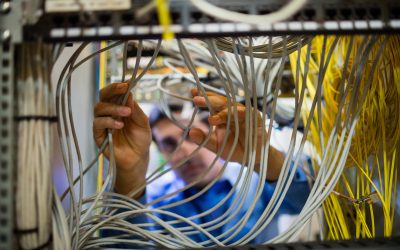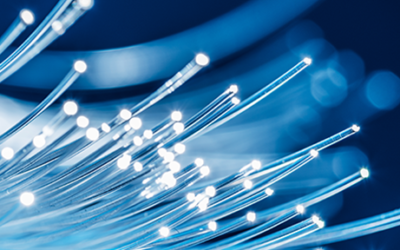Advice when planning an upgrade to your network

Tags: bottleneck | Gigabit | high speed | infrastructure
High-speed wired and wireless networking is not cheap, it’s not easy, and therefore it’s not always worth it.
Before you can estimate costs, you’ll need to determine which segments of your network you want to upgrade. This can be your most difficult planning task, because you’ll want to implement high-speed networking widely enough to provide you with adequate bandwidth for the foreseeable future, but not implement any more than you’ll really need during that time because of the costs associated with it. Here are a few guidelines to help you develop a good scope for you network project:
- Upgrade your network to see you through the next 18-24 months. Upgrades intended to last less than that amount of time will be outdated nearly before they are complete. The future beyond 24 months is too unpredictable. Under no circumstances should you claim that no further upgrades will be required for more than two years – the networking industry is changing too fast to make such dangerous assertions!
- Whenever possible, upgrade your cable plant universally. For example, if you’re going to have to upgrade high-speed segments from Category 5e to Category 6 or 6A cable, go ahead and upgrade your whole network to Category 6/6A. The incremental cost of upgrading cable is fairly low, and having a versatile cable plant will save you time and money in the future.
- Upgrade the busiest 20 percent of your network. The 80-20 rule usually applies in networking as well, so upgrading the top 20 percent of bandwidth-starved segments should cover most of your problem areas.
HARDWARE REQUIREMENTS
The cost of equipment is probably the first and most obvious expense related to installing a high-speed network. What may not be so obvious, however, are the many costs directly and indirectly related to installing new hardware.
A SMOOTH ROAD
Don’t forget that you may need to upgrade your cable plant. Also, remember that new media will require new patch cables.
SERVICE COST
You may need help with all of this. Consider the cost of any outside service providers you may retain to help you with your high-speed networking implementation. This will include contract programmers to help you enhance applications, network integrators to help you upgrade your servers and network operating system, as well as your switches and routers. Finally, you may need to hire cabling contractors to help upgrade racks, risers, and patch panels in your wiring closets.
STAFFING AND STAFF DEVELOPMENT
Hiring and/or training a staff to install and maintain a high-speed network is a significant expense. Because, as we have mentioned earlier, some high-speed networking technologies are relatively new, chances are your current staff hasn’t been adequately trained in them. Therefore, before you dive into a high-speed network implementation, you’ll need to make sure that your staff has acquired the necessary skills both in troubleshooting and management.
Sometimes developing existing staff isn’t enough. You may even have to hire additional staff that are already experienced in high-speed networking. If that’s the case, be sure to include recruiting and hiring costs into your implementation budget.
TIME ESTIMATE
One of the hardest figures to estimate is that of time. Come up with an estimated time to upgrade each server, router, workstation and switch; then, multiply that by the number of units of each piece of equipment you will convert.
Don’t forget, the cost isn’t limited to just time spent on the actual installation and configuration of your high-speed network. A major expense of converting your network protocol will be the costs of downtime, reduced productivity of everyone in your organization while systems are being optimized and the inevitable conversion problems are being solved, and reduced productivity of your staff while they become comfortable with the new equipment, software, and systems. Also, don’t forget the opportunity cost associated with the network conversion: what won’t get done well, or get done at all, while your staff is concentrating on implementing the high-speed protocol?
APPLICATIONS
In some instances, you will need to upgrade applications as well as hardware. For example, you may need new network management applications to monitor and manage the new protocol.
WEIGH UP THE EMOTIONAL COST
Another issue to consider before undertaking a conversion to high-speed networking is the emotional cost. Whether and when it is worthwhile to install a high-speed network depends a lot on the condition of your company and your department. As you will learn, implementing a high-speed network can be a costly, laborious, time-consuming, and nerve-wracking project. Therefore, if your company is in the midst of, say, a reorganization, or a financial crisis, the stress of such a conversion will more than likely far outweigh its benefits. The same is true of your department. If you’re having moral problems before you begin a high-speed networking conversion, you may not even have a department left when it’s complete.
IF YOU STILL FIND IT’S WORTH IT
Okay, you’ve figured in the cost of equipment, staff, applications, services, and morale, and it is clear there is a need to implement a new high-speed network. Now it’s time to get the budget and to plan the implementation
FIRST: IDENTIFY THE NEXT BOTTLENECK
As you probably know, improving network performance is simply a matter of moving the bottlenecks around. Right now, your network’s bottleneck is inadequate bandwidth. When that is eased, where will the bottleneck be? Will it be under-powered servers? Out of date workstations? Under-specified cabling? At the same time you are making your pitch for new networks, you should tell your management where the next slowdown will be and what will cause it. This will add to your credibility, and save you from discussion that begin, “You said if we put in this network, the network would speed up! What happened”
SECOND: MAKE A SCHEDULE
Create a schedule for the project. Determine the order in which the upgrades and installations will have to be done in your organisation. Be sure to figure in ordering lead times and delivery delays. Then create some form of planning chart showing dependencies and which steps have to be completed before others can begin. Assign beginning and ending dates.
CLASS TIME
Consult with training companies ,like the Cabling Science Institute or in – house instructors to create a schedule for training staff and network users. Timing is critical here. Training should take place close to the time of network implementation, or everyone will have forgotten what they learned by the time the network is in place. If you have a lot of people to train, you’ll probably want to use the outside e-learning specialists even if you have in house trainers, so that everyone can receive training shortly before the new network is out into service.
THIRD: GET YOUR BUDGET APPROVED
Once you know everything you have to do and buy, how much will it cost, and how long will it take, it’s time to get your final budget approved. Frequently it’s difficult for a network manager to justify to a non-technical management committee the expense of building a high-speed network and it’s infrastructure. You know it will increase performance, thus saving time and making network users more productive. Productivity, however, is a difficult thing to quantify. Indeed, a high-speed network and infrastructure may be helpful, even vital, to your organisation. But given the reluctance of the powers that be to spend money on anything that won’t show a tangible economic benefit, how do you convince them to approve the expenditures to build one?
The answer is deceptively simple: Put a price on it. Determine:
- How much the system really costs
- How much money it will really save (or make), and
- Figure out if the difference is worth it.
You will get a lot more attention when you present a purchase request in terms of money it can make or save your company than when you recommend it for convenience and ease of use. Telling your boss that a high-speed network will improve response time is one thing. Pointing out that having one is like getting an extra workday from each user each year is quite another.
The first step to putting a price on the benefit of a high-speed network and cabling is to take an objective look at life without the product, past, present and future. Ask yourself what past problems the high-speed infrastructure could have eased. For example, did the network in accounting slow to a standstill during the year-end closing last January? Are your remote offices unable to start work on time each morning because the nightly data transfers from headquarters are taking too long to complete? Use these as concrete examples for your management of how the high-speed network will be used in your organisation.
Next, ask yourself what will – or won’t – happen in the future if you don’t build a high-speed infrastructure. Then figure out how that will affect your business. For example, survey your network users to find out how long it takes to complete a print job on a network printer. At the same time, ask them how much they expect their printing to increase over the next few quarters.
As another example, let’s say that you manage a network with 2,500 users, and you find through your survey that on the average it takes users ten seconds to save a document. According to your research, the same task on a high-speed network would take two seconds. You also find, through your document management system, that the average network user saves 15 documents a day. ‘Eight seconds’ You say, ‘big deal’. A little math will show you that this is a very big deal indeed:
8 seconds x 15 documents x 250 = 8.33 hours per year.
This means that saving eight seconds per saved document amounts to saving a day’s worth of work each year. Your friendly accounting department can help you put a dollar value on this. Suppose you find that the average salary of a network user is $35,000. A day’s salary for an average network user would be $140. Getting an extra day’s work each year from all 2,500 users would mean an annual savings of $350,000. That should certainly get your manager’s attention.
CONSIDERING THE ALTERNATIVE
It’s time to concede that a high-speed network and cabling is not only the solution. There may be other ways to solve the problem. To have a persuasive pitch, you will have to acknowledge that there are alternatives and show that you have considered them. Then you have to reveal their inadequacies – if you can.
SHOWTIME
Now that you’ve gathered your facts, found the costs and shortcomings in your own solution, addressed the holes in your own logic and built a case based on economic need and common sense, it’s time to prepare your presentation. Start by telling your management how much the new infrastructure will save the company. Then give your example of a past project that would have been done more cost – effectively if the infrastructure had been in place. Next, present the worst – case scenario if the network isn’t built, then conclude with a step-by-step explanation of the analysis you used to arrive at these conclusions. Finally, just in case your arguments sparks enthusiasm, it’s a good idea to have a high-level implementation plan on hard to give your management an idea of what will be involved.
YOU CAN’T ALWAYS GET WHAT YOU WANT
Your analysis has either produced a sound, justifiable and hopefully unassailable case for building a high-speed network and the cabling to support it, or a reasonable explanation of why the project just isn’t feasible. In either instance you win. Understanding why a purchase doesn’t just make business sense will build your credibility with your management just as much as knowing when it does. It also makes you aware of the types of systems and pricing that will make sense.
This exercise will also give you more than a business case for building a high-speed infrastructure. It will help you gain a broad perspective on how your network and cabling fits into your organization. It also encourages constant, close communication with other departments and an understanding of how they use the infrastructure and information about the network. This is the kind of perspective that will not only make you a better network manager, but also serve well throughout your career.
FOURTH: SET EXPECTATIONS
As soon as you complete your implementation plan and schedule for your high-speed infrastructure, start setting appropriate expectations for your managers, your users, and your staff. Here are some tips:
- Write a e-memo, hold meetings, post notices, and talk with everyone you meet in the hall about what you are doing and why. Explain it in excruciating detail. Tell them why it is necessary. Be a walking, talking seminar on building your new network. Even though some people may not understand everything you’re saying, they will have an opportunity to grasp the enormity of the undertaking and perhaps be more sympathetic to any difficulties encountered as a result.
- Listen to their concerns about ‘another network project’. Everyone dreads having the network down, and it often seems that every major network upgrade or conversation is followed by a frustrating period of sporadic downtime while working out the ‘bugs’. Some users may be anxious about the network project because they are about to begin demanding projects of their own. You should be aware of these projects and plan network implementation accordingly. After talking with your users, you may even want to reschedule so that the network won’t be ‘under construction’ during a critical work period such as tax season at an accounting firm or large trial at a law firm.
- Be very candid about how long the project will take. You will gain nothing by being overly optimistic. If anything, overestimate the duration of the implementation.
- Let all concerned know where and when you are likely to encounter problems or delays. At the same time, share your contingency plans for meeting important deadlines and keeping the work flowing even when the project isn’t going as well as planned.
- Don’t oversell the expected performance increases. Obviously, you wouldn’t be undertaking the project if you didn’t think it was worthwhile. However, while you should be positive about the benefits of a high-speed network, don’t make anyone expect a miracle.
- Prepare your staff for long hours. Be sure you have communicated very clearly exactly what this project is going to demand of them. Show them the schedule and the task assignments. Be sure everyone is committed to successful completion of the project. Then help them prepare for it.
- Be prepared for cranky users. No matter how carefully and thoroughly you communicate, there will no doubt be a user or two who become frustrated with the progress of the project and lashes out at you and/or your staff. Don’t take it personally (no matter how personally it is aimed) and make sure your staff doesn’t either. Tell them that this is likely to happen, and instruct them to listen patiently to angry users, apologise for any inconvenience, and tell the users what is being done, and walk away.
SURVIVING NETWORK PROJECTS
This sounds more like you’re preparing for war than for network upgrade. However, it’s not meant to scare you away from building a high-speed network infrastructure. In fact, it’s aim is to ensure that you come away from the project with a high performance infrastructure and an intact career. In summary, the secret to successful implementation is:
- Doing your homework and carefully selecting which protocols and products to implement where
- Carefully planning and scheduling the tasks and expenditures
- Preparing your staff, your users and your management
It is no secret that network managers are under constant pressure to offer more services, to more users, sites, and applications, while coping with different protocols and technologies. New multimedia-rich applications are demanding more bandwidth and better throughput than ever before. In addition, network managers are asked to minimize the risk of downtime and failure, or rather maximize uptime, while lowering costs. To combat the risk of network failure, a network manager needs to build in tolerance, installing high performance, high quality systems and choose vendors who can offer reliable support worldwide. At the same time, they need to protect against uncertain future developments in technologies, products, and applications that may require major (and costly) upgrades. This risk is managed only through a careful selection of systems with reliability, scalability and open standards in mind. This is particularly true for the physical layer of the network.
If you are interested in learning more, take a look at the Network Project Planning and Safety or Network Infrastructure Test and Inspection courses.

Written by James Donovan
You might also enjoy
FO Connector Contamination – A Constant Threat
Fiber optic communication most commonly works in duplex or multifiber transmission by transmitting light to a receiver in one direction on a fiber and receiving transmitted light back to a second receiver on the second fiber. Most engineers can understand that and...
Why Inspect and Clean Fiber Optic Connectors?
Inspecting and cleaning of fiber optic connectors during installation and when making any patching, is essential. Any contamination on a patch cord connector will be transferred through the coupler to the connector it is mated to. Even when testing fibers with a test...
Cleaning MPOs
MPO connectors should always be inspected with a scope before they are used, be that on a patch cord or a bulkhead. If they need to be cleaned, one-click cleaners are keyed to ensure the tip only fits one way onto the connectors and is able to clean both male and...


